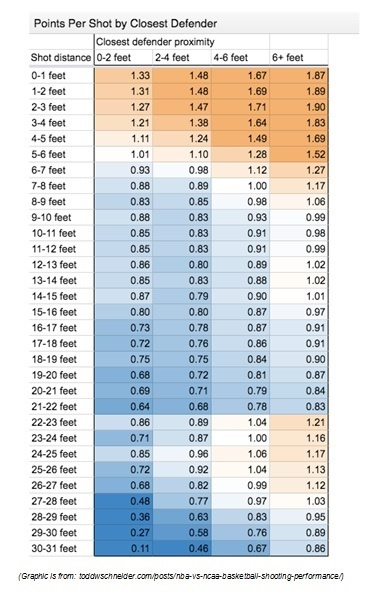The #1 goal of a Great Transition Offense
A few years ago, when we reviewed some NBA data, even a heavily contested layup ranged from 1.27 to 1.33 points per shot...
While wide open 3-point shots from 22-23 feet were lower at 1.21.
So even heavily contested layups got better results than wide open 3-pointers!

So it may come as no surprise that Don Kelbick's basic philosophy in transition is...
I want a layup!
We'll elaborate more on this unique approach in a minute.
But first, we also need to address the first thing Don believes you need to cover when it comes to attacking in transition...
Establish Your Break Objectives!
In fact, here are his words verbatim on the topic, right from his eBook...
When running a transition game, I think the single most important things to establish are your break objectives. What do you want to get out of your break? Coaches do it with the offense. Coaches do it with the defense. How many coaches address it with their break? I don't expect anyone to assume my priorities. But, since this is my writing, below are my objectives.
Situation
2 on 1
3 on 1
4 on 1
3 on 2
4 on 2
5 on 2
4 on 3
5 on 3
5 on 4
Objective
Layup
Layup
Layup
Layup, mid-range shot on reversal
Layup
Layup
Transition Offense
Layup, Mid-range shot on reversal
Transition Offense
I have enough confidence in anything I run on offense to be able to get a jump shot or a 3 when we want. To waste an advantage situation to chuck on up at the basket seems like a wasted opportunity to me.
Now, let's get back to Don's philosophy on why he wants a layup in transition...
I already mentioned above about running an advantage break to a jump shot – a waste of effort. I want layup, layup, layup.
It is a mindset. Attack, Attack, Attack!
The first rule of my break is to get the ball to the best finisher and he thinks, "Layup, layup, layup."
I do not discuss or drill, "force the defense to make a decision," or "make the defense commit." I don't care about that. I don't want my finisher to think about passing.
I don't care if he runs over the defense. I want him thinking, "layup."
I want the other players to know that. I want them to continue to run hard to the backboard thinking rebound. If we are 2-on-1 and the ball handler goes to the basket and misses, the other player should be 1-on-0 for the rebound.
The philosophy is the same on other advantage breaks. Of course, we do go over what to do if he can't get the layup, but that is almost an afterthought.
Players will naturally revert to laying the ball off if they don't have a layup, but I do not want them thinking about it.
It is difficult to get players to think about going to the basket and it takes constant reinforcement.
If this piqued your interest and you'd like to learn more about Don Kelbick's philosophies and approach on his transition offense system, click here.


 Facebook (145k Followers)
Facebook (145k Followers) YouTube (152k Subscribers)
YouTube (152k Subscribers) Twitter (33k Followers)
Twitter (33k Followers) Q&A Forum
Q&A Forum Podcasts
Podcasts